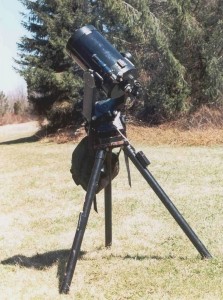| Jack of All Trades in the year 2001 The 8" Schmidt Cassegrain Telescope is a general good performer in many areas. The Celstar 8 itself gives excellent lunar and planetary images and excellent images of deepsky objects. The motor drive needs only a 9 volt DC battery. This scope can be very sucessful at producing stunning astrophotos. My favorite aspect of the Celstar 8 is its portability and ease of use. When attention is paid to the collimation of this scope you have an instrument which performs like a Champ! This scope has shown me the faint members of Stephan's Quintet, the Encke Division of Saturn, all Six of the Trapezium, a wealth of Jovian details, and variable stars slightly past 14.2 magnitude on many occasions. 
The Motor Drive One of my favorite aspects of this scope, is that it contains a motor drive. It is very relaxing to sit in a chair, lock the drive clutch, and observe an object. Or better yet to come back thirty minutes later and the object will still be in the eyepiece (granted a reasonable polar alignment was performed). The motor drive has been invaluable for making variable star estimates and planetary observations. Many times I have done variable star estimates of faint variables at 225X with the TV 9mm Nagler eyepiece attached to the Celestar 8. Higher magnification darkens the sky background, allowing fainter stars to be observed. CM transit timings of Jovian Features have also been caried out at 150-225X. The motor drive has even been a big help in locating and observing faint deepsky objects, such as Stephans Quintet. For observing Stephans Quintet, high powers were used again to increase image contrast. (Also a blanket was used a!s a light shroud to gain full dark adaptation!) As you can see many of my visual observing is actually done at magnifications of 150-225X.
While the lack of a motor drive would not make these observations impossible, it would make them very difficult to do. Portability of the
Celstar 8
I have owned my Celstar 8 for at least 5 yrs, and must say that in my opinion it is one of the best commercial 8"SCT's available in this price range. The Optical Tube Assembly only weighs 25lbs, and the tripod weighs 15lbs. This makes the scope very light and portable.
The Celstar 8 can quickly be transported down our apartments stairs, then a few hundred feet to my observing site. The portablility of this scope has helped me carry out frequent variable observing sessions from our residence. The Celestar 8 can easily be place in my Honda Civic and transported to our NJAA Club Observatory in High Bridge, NJ
Astrophotography with the
Celstar 8
Granted this is not a heavy SCT design. Heavier SCT designs may be better for Astrophotography, also the spur gear of the Celstar 8 Standard version leaves a little to be desired.
But long prime focus Astro photos can be done. Mark Hansen has successfully taken several long exposure prime focus photographs with the Celestar standard version. The trick is to use an elastic bungee cord to put a small amount of pressure on the fork arm. This tightens the gear mechanism reducing slop. Hence this cuts dramatically down on tracking error's producer by the motor drive. If you are more for visual observing and only care to dabble in Astrophotography, then I would suggest this scope over a heavier SCT design.
Personally, I need a light scope which is easy to transport and setup, but still has a motor drive and a reasonable aperature. The Celstar 8 Standard Version fits the bill!
The importance of a Dew Cap
Just recently it has come to my attention the importance of using a dew cap with the Celstar 8. While the dew cap prevents dew from forming on your corrector plate, few people probably realize how much stray light the dew cap can prevent from entering the tube. Since I live in New Jersey, the dew cap is almost always on my scope. One night while looking through a friendís 8"SCT, there appeared to be something wrong. The view of M13 through my friendís scope at 225X appeared to lack contrast. But the view of the cluster thorough my own scope was excellent. The only difference between the scopes was the fact that my scope had a dew cap in place. After removing my dew cap and placing it on my friendís scope, the truth became obvious. A dew cap truly helps give a SCT more contrast!
If you don't believe me then try a simple experiment yourself to see the difference. Bet you will be surprised!
Accessories for the Celstar 8
The first thing I did was get rid of the straight through finderscope. It kills your neck, and is impossible to use. This was replaced with a used Meade 6*30 right angle finderscope from the Telescope Warehouse. If you can afford a larger right angle finderscope than go for it. The Meade 6*30 fit my budget at the time.
The second addition to the scope was a telerad like finderscope from Orion. This made the scope much more user friendly and only cost $30. Hopefully in the future, I will purchase digital setting circles for my scope.
Probably the best two eyepieces for this scope are the Telvue 9mm Nagler, and Meade 14 Ultra Wide Field of View eyepiece. Unfortunately both of these are expensive, and the Meade 14 UW will only fit into a 2" star diagonal. As of now I only own the 9mm Nagler. Other than that I suggest buying a good barlow lens (for lunar and planetary work or collimation) and some good plossil eyepieces. You may want to also consider a solar filter. What ever you do, the Celstar 8 will not let you down.
|